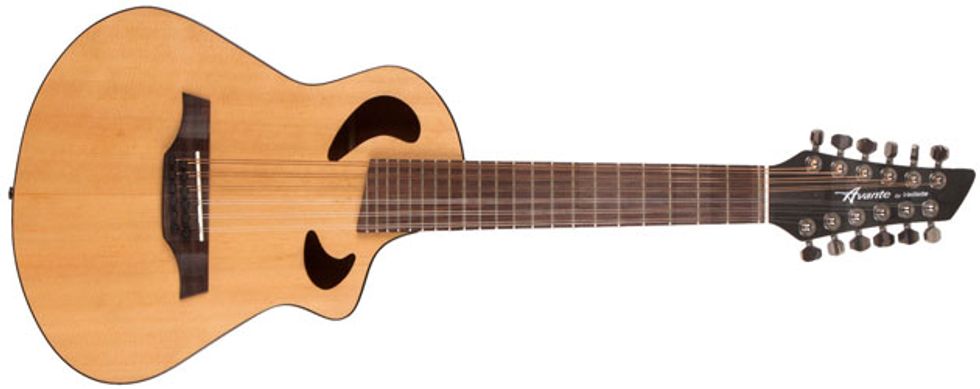Session players—especially ones who do lots of soundtrack and jingle work—often carry a double-course instrument to imitate various folk instruments. If they play the right notes with the right inflection, they can use a single axe to mimic Italian or bluegrass mandolin, Cuban tres, Greek bouzouki, Turkish cümbüs, Puerto Rican cuatro, various Middle Eastern lutes, or any other high-tuned instrument with double strings. The same instrument might also double standard acoustic for a 12-string or Nashville high-strung effect.
One cool upscale option for a do-it-all double-course/high-strung axe is the Veillette Gryphon—a small-bodied, short-scale 12-string tuned like a standard guitar, but transposed up a minor 7th (equivalent to having a capo at the 10th fret). Gryphons sound, feel, and look great. They record like a dream, and they spare players from grappling with non-guitar tunings. The only catch has been their price: a hand-built Gryphon will set you back over four grand.
Which brings us to the new Avante Gryphon: a CNC-constructed, Korean-made version that sells for a relatively modest $1,495.
Let’s Get High
The Avante Gryphon is a cute little critter with a smooth, deep cutaway and a pair of boomerang-shaped soundholes. With an overall length of 32.5", it roughly splits the size difference between guitar and mandolin. Its 21 frets are more closely spaced than on a guitar, but roomier than on a mandolin. I suspect most players without unusually fat fingers will get around comfortably.
By necessity, the Gryphon is neck-heavy—after all, it requires 12 quality tuners and a sizeable headstock to house them. (The headstock’s length is more than half that of the entire fretboard.) But the instrument is still light overall, and the body’s shape places your picking-hand elbow in a good anchoring position, both playing and standing. Some players may need a bit of practice before they feel at home on the Gryphon, but most will sail smoothly before long.
The instrument has the feel of a quality CNC guitar. The body’s spruce and mahogany are attractive and evenly grained beneath an immaculate gloss finish. The neck’s relatively high width-to-length ratio may feel odd at first, yet its silky matte finish and 1 15/16" nut width are comfy-cozy. A modest volute provides a stabilizing thumb perch. It’s equally easy to play speedy single-note mandolin-style runs and big strummed chords. I even found the neck wide enough for intricate fingerstyle stuff, though players with bigger hands may not agree.
The fretwork generally feels nice, but there are issues with the topmost register: The first string pair “frets out” above the 15th fret, so the instrument’s highest four pitches are unavailable without additional fretwork and/or neck adjustment. There are also problematic notes at these frets on the second and third courses. Granted, most players aren’t likely to linger in this register. But if you view the Gryphon as a way to extend the guitar’s range by nearly an octave for overdubbed/ensemble passages, every half-step counts. (Veillette subsequently sent a second Avant Gryphon for review. It had no such problems, and fretted perfectly throughout its range.)
But overall, the Gryphon sounds great. No, make that exquisite.
Twinkle, Twinkle Little Guitar
Sonically, the Gryphon is a kissing cousin to a fine mandolin, but with a more mass. Notes leap from the instrument with a percussive, midrange-forward snap. Obviously, the small body doesn’t move many lows, at least at the recommended DGCFAD tuning (that is, nearly an octave above standard). But notes have body, warmth, and no trace of cheapo plywood “plinkiness.” But the most beguiling facet of the Gryphon’s tone—at least for doubling/overdubbing purposes—is its glistening, bell-like high end. I can’t think of a better way to powder a track with magic fairy dust. Or grease it with enchanted elf oil. Or marinate it in mystic leprechaun juice. It’s twinkle, twinkle for days.
Ratings
Pros:
Quality build. Superb tone. A great session tool.
Cons:
Problems above the 15th fret. A bit pricy for an imported CNC instrument.
Tones:
Playability:
Build/Design:
Value:
Street:
$1,495 street (includes reinforced case)
Veillette Avante Gryphon
veilletteguitars.com
With a range extending a fourth below that of a mandolin (or a fifth, if you drop the low D pair to C), the Gryphon is a surprisingly satisfying solo instrument. Unlike a standard-tuned 12-string, which has octave pairs on the lower courses and unisons on the upper ones, all six Gryphon courses are unisons. This sidesteps a frequent problem with playing melodies on 12-string: the jarring timbral contrast between the unison second course and octave third course. Linear melodies are more idiomatic to the Gryphon than to a standard 12-string.
Intonation Celebration
The Gryphon also wins high marks for playing in tune. It certainly intonates better than any of the janky mandolins, cuatros, and other folk instruments I’ve wrestled in the studio over the years. (Good tuners help.) And man, does it track well! The day I received the review model I had a recording session for a video game franchise whose name I can’t mention yet. The score emphasizes acoustic instruments, and the Gryphon seemed to slot right in wherever we tried it. It sounded glorious through a pair of high-end, small-condenser Schoeps mics.
Meanwhile, I recorded the Bach prelude in the demo clip on a mobile rig when I was home for the holidays. The Gryphon still sounds nice through the modest internal mic and relatively noisy preamp of a Line 6 VX Port Pro. The Gryphon also includes a built-in piezo mic/preamp that lets you plug in via the endpin jack.
The Verdict
Not everyone can afford $1,495 for a once-in-a-while flavor, however delicious. But for creative players, the Gryphon may be more than an occasional color. It excels as a solo instrument, and even more so as a doubling/orchestrating tool. This boldly imagined axe is well made, ultra-playable, and extremely useful. The Gryphon is a shimmering acoustic gem.






















